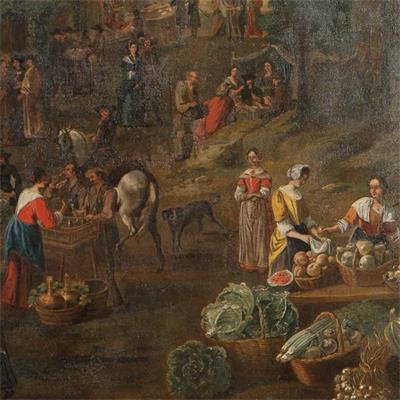In the background of a conventional landscape, in the large space in front of the church a great many typical scenes of markets or fairs are painted. We can see pilgrims and priests, nobles and commoners, street sellers and animals: some people are travelling in the carriage, others are walking, playing cards, selling or buying food or wine. In the foreground on the right a fruit stall stands out with huge vegetables and fruits.
Euclide Milano reported in the local newspaper “Eco della Zizzola” in 1919: "...a large painting representing the Sanctuary of Madonna dei Fiori (Our Lady of Flowers) as it looked like in the eighteenth century, with scenes of a festival on the patron saint’s day ...". The church depicted here is the sanctuary before the reconstruction of the façade in 1844.
The style of the painting led to the attribution to Pieter Bolkman or Borgomans (Gorinchem, Utrecht 1640 - Turin 1710), a Flemish painter who arrived in Piedmont in 1679 after working in Rome for some time, where he made paintings for the royal court that fall within the genre of the so-called "bambocciate". Bamboccianti were defined as the painters followers of Bamboccio, the Dutch artist Pieter Van Laer, whose nickname referred to his deformity. In their works we find accurate descriptions of scenes of everyday and popular life (street sellers, card and morra players, parties, processions, country fairs and so on).



